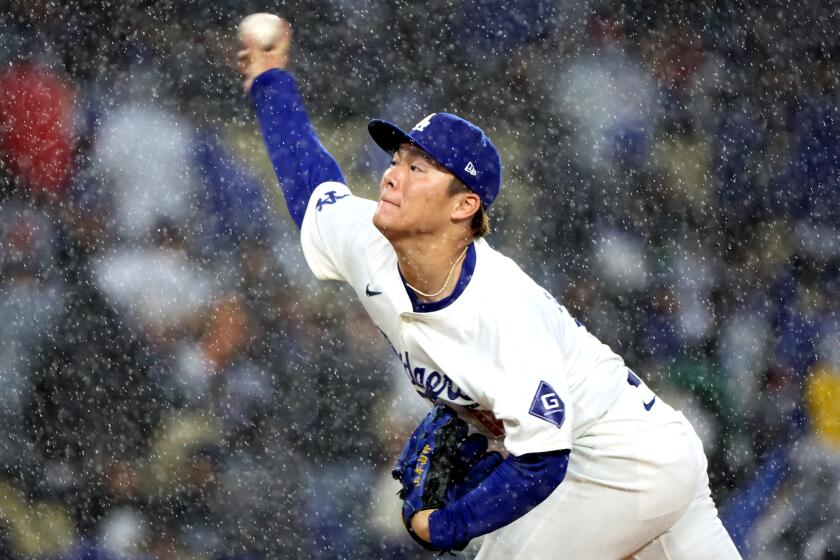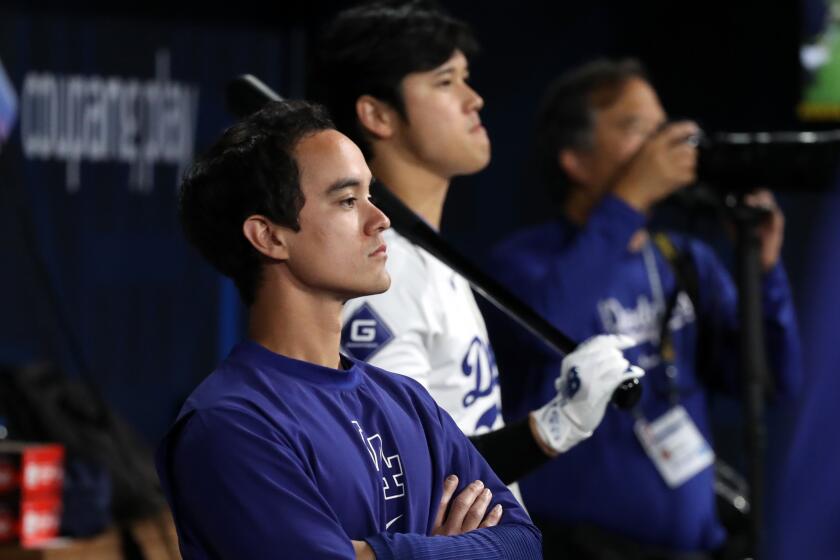Shohei Ohtani focused on swing after quiet, yet productive, opening week with Dodgers
Dodgers designated hitter Shohei Ohtani follows through on a swing during their game against the Cardinals on Monday. (Gina Ferazzi / Los Angeles Times)
The moment was begging for a thunderous swing.
So was the 91-mph fastball that St. Louis Cardinals reliever Giovanny Gallegos had grooved down the middle of the plate.
Last Saturday night, in what could have been his first signature moment as a member of the Dodgers, Shohei Ohtani tried to oblige. He saw where the pitch was headed, with the bases loaded and two outs in the 10th inning. He tapped his front toe and uncorked his bat, feeling the ball explode off the barrel with a vicious left-handed swing.
“I thought I hit it well,” Ohtani said afterward through acting interpreter Will Ireton.
“He got a pitch that was about 91 [mph] and in his nitro zone,” manager Dave Roberts added.
Shohei Ohtani pops out with the bases loaded in the 10th inning as the Dodgers lose to the St. Louis Cardinals after a strong start by Yoshinobu Yamamoto.
But, instead of looking up to see a walk-off base hit or game-winning grand slam, Ohtani grimaced at what was only a shallow game-ending pop out, frustratedly jogging back to the dugout at the end of the team’s only defeat so far in this week’s homestand.
“It ended up being a pop fly,” Ohtani said. “[It had] something to do with my timing, and just the distance I feel between myself and the ball.”
In Ohtani’s opening act as a Dodger, this is the best summation of how he has been feeling at the plate.
The two-time MVP is identifying pitches well, having struck out in only six of his 29 trips to the plate. When he makes contact, the ball is still rocketing off his bat, evidenced by his major-league-leading nine batted balls of 100 mph or more in exit velocity entering play Tuesday.
Yet, through seven games as a Dodger, Ohtani is batting just .267 with a .670 on-base-plus-slugging percentage, ranking fifth and sixth, respectively, among qualified hitters on his new team.
He has yet to hit a home run, extending his long-ball drought to 17 games going back to the end of last season — when he led the American League with 44 big flies, averaging one about every 14 times he came to the plate.
And while Ohtani has produced three doubles, three RBIs and key contributions to most of the Dodgers’ five early-season wins — including an RBI groundout and rally-sparking double Monday night — he has admittedly looked somewhat out of sync with his swing.
“I feel like I’m seeing the ball well,” Ohtani said this weekend. “But I feel like there’s a little bit something off with my timing and being able to kind of feel the distance between the ball and myself.”
This isn’t to be confused as some sign of sudden alarm.
On Sunday, Roberts said that while Ohtani has indeed “missed some pitches that he had a chance to move forward,” he believes that “the most important thing is that he’s healthy and seeing the baseball well.”
“He’s just so talented,” Roberts added. “The hits, the slug, all that stuff will happen.”
Hitting coach Aaron Bates echoed similar sentiments Monday.
He said some pitchers have seemingly pitched Ohtani carefully, and that Ohtani himself is still learning about National League foes he faced sporadically during his time with the Angels.
He acknowledged that the slugger’s “point of contact” — essentially, the spot in the swing where Ohtani makes contact with a pitch — has also varied a little bit in the early going, with Ohtani getting out in front of some breaking pitches, or getting his bat to the ball too late on hittable heaters.
Yet, Bates still praised the quality of at-bats Ohtani has taken, noting that, if this is what it looks like when the 29-year-old two-way star is working through mechanical tweaks, his potential for rapid improvement is still through the ceiling.
“I mean, his margin for error is so big, because he’s so strong, so fast,” Bates said of Ohtani, who has historically posted lower numbers in the first couple of months in his seven MLB seasons.
“He can be off a little bit and still get hits and compete and walk and do so many things for you,” Bates added. “That’s the luxury he has, even when he’s a little bit off, so to speak.”
All of this, of course, has come against the backdrop of the lingering off-field scandal involving Ohtani’s accusations of theft and gambling against his former interpreter, Ippei Mizuhara.
That situation, which initially erupted during the Dodgers’ season-opening trip to South Korea and culminated with a high-profile news conference once Ohtani and the team returned state-side, has calmed since the regular season resumed last Thursday.
For now, the daily scandal-related questions Ohtani once faced — though, never directly answered with reporters — have been replaced by more routine baseball-focused queries.
It means Ohtani’s focus has returned to an arena he can control, trying to kick-start his offense after a quiet, yet productive, opening week.
Bates lauded Ireton, Ohtani’s new interpreter, of helping ease that process. Coaches continue to remark about the increase of direct communication they’ve had with the $700-million signing in the wake of Mizuhara’s firing as well.
On Monday night, that was evidenced by an extended conversation among Ohtani, Ireton, Bates and fellow hitting coach Robert Van Scoyoc in the dugout after Ohtani’s first-inning groundout. As the coaches sat on a bench, with iPads in hand, Ohtani grabbed his bat and imitated his batting stance. Ireton also motioned with his hands while relaying the dialogue.
Will Ireton is Shohei Ohtani’s new interpreter for the Dodgers since the firing of Ippei Mizuhara amid a gambling scandal. He’s been with the team since 2016.
“When you’re talking about baseball and communicating with him,” Bates said, “he’s great.”
And, in his next trip to the plate, Ohtani slashed a low splitter past the first baseman and into right field for a double.
No thunderous swing, or towering first Dodgers home run. But plenty to keep the club optimistic there is much more in his swing he might soon unlock.
“For me, as I try to learn players, I watch how they handle some things, their emotions,” Roberts said. “And he’s just very consistent. He doesn’t waver in his preparation.”
More to Read
Are you a true-blue fan?
Get our Dodgers Dugout newsletter for insights, news and much more.
You may occasionally receive promotional content from the Los Angeles Times.












